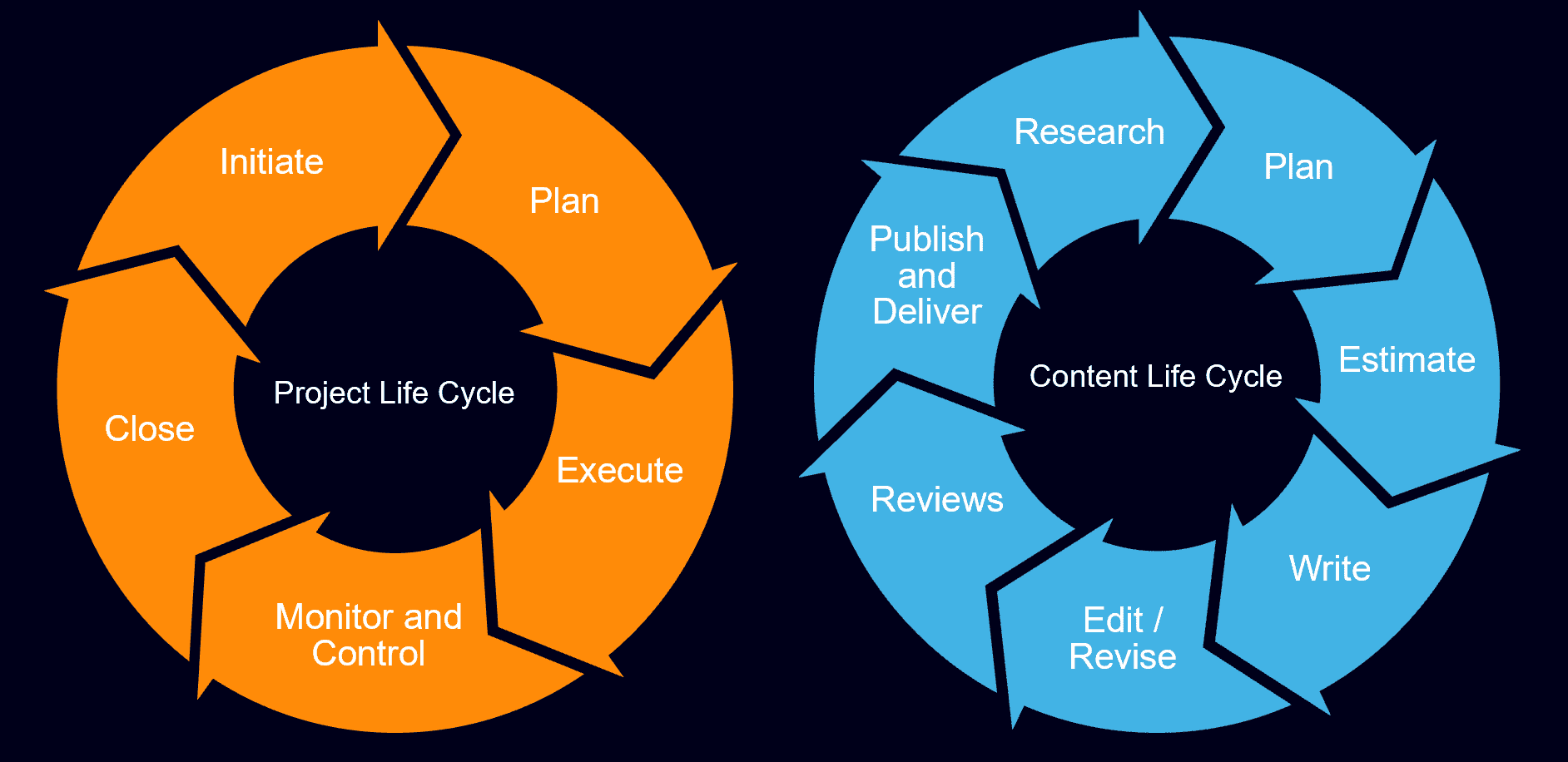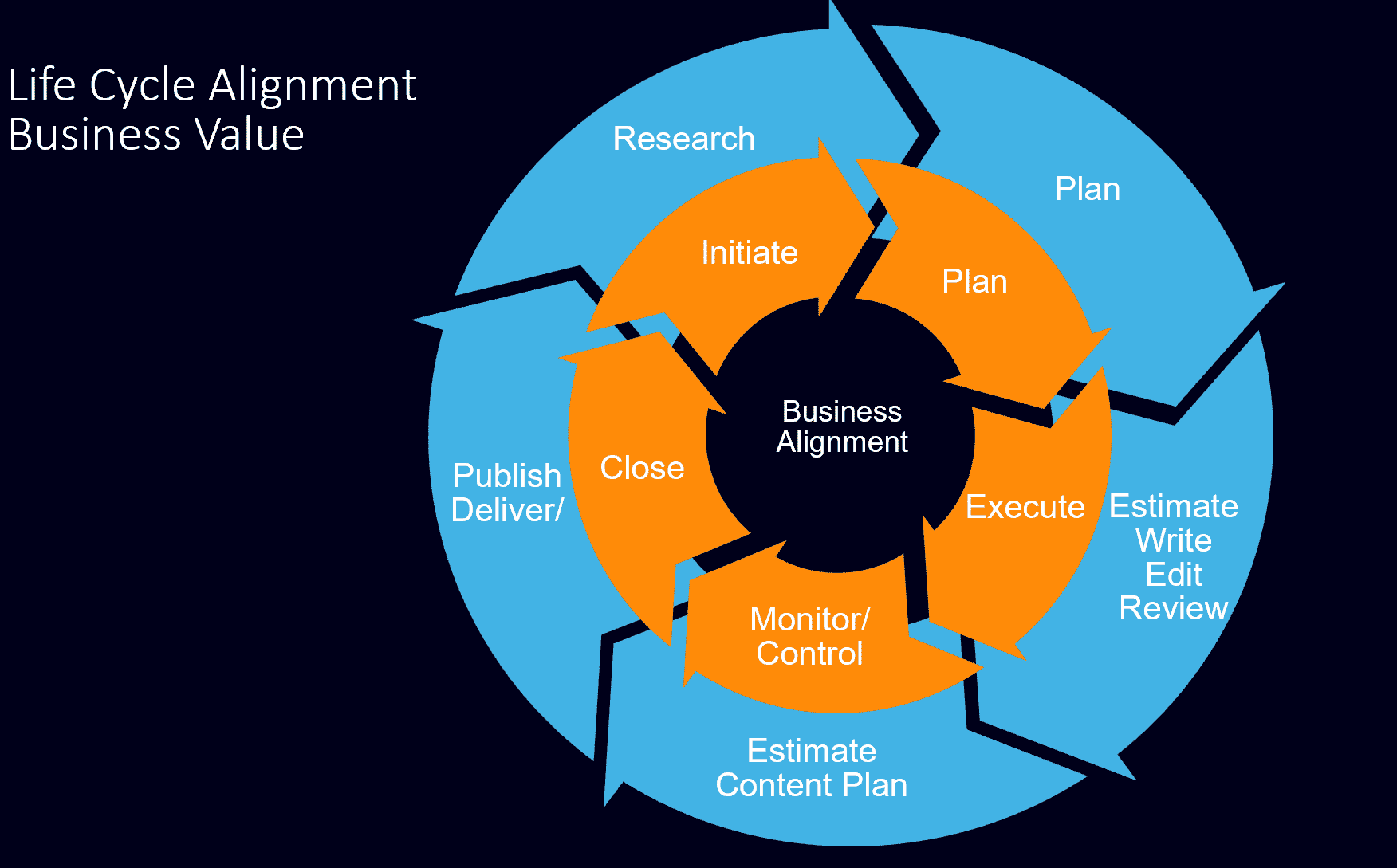The value of information developers is increasing in businesses across the globe. Their work plays a central part in customer satisfaction. Not only do information developers create content to support products and services, they build data that addresses businesses goals, and the information development role in ensuring the success of product projects.
Information developers support teams in staying on track by making estimates, benchmarks, and by communicating them to team members throughout the project.
In this blog, you’ll learn how connecting the Content Life Cycle (CLC) to the Project Life Cycle (PLC) allows information developers to align their work with the highest-level strategic goals and objectives of an organization, establishing strategic value.
Owning Your Strategic Role in the Organizational Structure
Information developers hold a pivotal role in organizations. For them to carry out their work successfully, it is important that other members recognize their added value. Here are a few ways they can demonstrate it:
- Be visible. Information developers must let other organization members know what they are doing and build trust with them to be granted access to the information they need to be successful.
- Prove to be essential. People should be aware of the work information developers deliver, and how it benefits the organization.
- Map goals and objectives and connect them to the highest-level strategic goals and objectives of the organization.
- Find a sponsor. Information developers should find someone in senior leadership that champions their work within the company.
- Align themselves with high-priority projects within the group that funds the project to draw attention to their deliverables.
Connecting the Project Life Cycle (PLC) to the Content Life Cycle (CLC)
The Project Life Cycle is what the project manager depends on to conduct successful implementation by making a framework for projects.
Information developers rely on the Content Life Cycle to guide their work. It corresponds to the process of content creation and communication management for this content.

These two life cycles are similar, but generally work separately. Drawing a connection between the CLC and PLC will further support information developers to demonstrate their business value, and attain successful project outcomes.
To do so, information developers must make a parallel between PLC and CLC for each phase of these cycles, and identify how CLC fits into the project.
1. Initiate
The first phase of PLC consists of deciding whether the project will be executed, based on the study of two documents:
- The business case document supports the need for the project, and includes an estimate of potential financial benefits.
- The feasibility study evaluates the project’s goals, timeline, and costs, to determine whether the project should be carried out.
If a project fails either or both profitability and feasibility tests, chances are the project team will not move forward with it. Conversely, a project that passes these tests will likely be assigned to a project team or project office.
During this phase, the information developer must identify everything they need to succeed the project, and ask for it.
This corresponds to the research phase at the CLC level. At the end of this phase, the information developer should be in the position to answer the question: ‘’What business problem does this project solve?’’
Other questions to ask could be:
- Does information development (ID) provide an estimate for effort?
- Is ID informed and included in feasibility?
- Is special training required?
As they collect answers, information developers integrate them to an initial estimate document. Data gathered from past projects will also make possible to estimate project overhead, with different scenarios, and feature work. Their findings will influence their work, and the project success. The file is then submitted to the project manager for approval.
2. Plan
Once the project is approved, the project manager designs a project plan. It guides the team to produce quality outputs, handle risk, and conduct their work properly while staying on time and on budget.
The project plan usually includes a statement of work, a resources list, a work breakdown structure, a schedule, and a risk plan. These documents aim at making the project viable.
In the Content Life Cycle, the planning phase consists of:
- Assigning resources
- Developing a content plan
- Identifying stakeholders, requirements, and processes
- Getting agreement for planned deliverables
It is essential that information developers develop a content plan, a process, and KPIs to drive their work.
3. Execute
The execution phase of the PLC relies heavily on the planning phase. It is no longer possible to make changes to the costs, scope, and timeframe previously established. It entails building deliverables that respond to customers’ requirements. The project manager organizes its team by assigning them to certain tasks:
- Defining the project scope
- Managing the team’s work
- Recommending changes and corrective actions, and documenting changes as they occur
- Managing the project communication with stakeholders
- Hosting status meetings
The tactical work then begins for information developers with the estimate, write, edit/revise, review, and publish phases of the CLC.
Information developers start attending the Program Increment (PI) planning, and sprints. During these meetings they gather information, contribute to the planning, and work on the project. Sprint reviews are the opportunity for IDs to feature their work with demos. This is also the time when they communicate positive progress, risks, and any obstacles to the project completion to team members and the project manager.
4. Monitor and Control
Monitor and control often occur at the same time as execution in the PLC. As the project is being executed, the project manager monitors how the team is doing in terms of project advancement.
In the CLC, information developers should track their progress, and always maintain an up-to-date status . Although it requires additional time and effort, it is essential for IDs to know their progress and status, and alert product teams know if they identify any issue or if there is any change in scope as this will affect timeframe.
This phase enables tracking any cost or time variations, and ensures the project runs smoothly.
Note that while internal systems are set up to gather data (MS Project, JIRA, Trello, SAP, Teamwork, Confluence), using tools that aren’t connected will make gathering and compiling data more complicated.
5. Close
The close phase is the delivering phase of the PLC:
- The finished product is delivered to the customer.
- Stakeholders are informed of the project completion.
- Resources are released to other projects.
This step is important for teams to evaluate and document the project. The team assesses mistakes and successes that occur during the project to build stronger processes, and more successful teams for future projects.
The project manager identifies key project achievements and milestones, and documents takeaways.
In parallel, information developers complete the publish and deliver phases of the CLC:
- Complete release documents
- Verify to have metric quality requirements
- Finalize ID system files and confirm they are reproducible
- Evaluate what went well and what did not, and suggest solutions to issues that came up
- Identify ways to improve ID processes and deliverables
- Compile and deliver a release report
- Recognize team members who contributed to the project success and thank them openly
The release report is a valuable document that gives a concrete project overview to stakeholders. It includes insights on the customer’s goals and how they were satisfied, whether deliverables met deadlines, if estimates were accurate, the KPI score, and content metrics to prove return on investment.

These phases lead to a business value alignment, when the CLC and the PLC are used together.
Connecting the CLC and PLC allow information developers to demonstrate their business value. The steps they follow to achieve business alignment can be summed up as such:
- Map ID work to business goals and objectives over tools and processes
- Plan strategically, deliver tactically
- Integrate and communicate outside your role
- Support change with accountability
They can clearly prove their added value throughout a project and its successful completion.
This blog was originally presented as a IXIAtalks webinar with Mollye Barrett, Information Development Manager. You can find the webinar here.
Learn more about our IXIAtalks webinar series.







